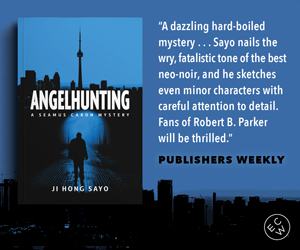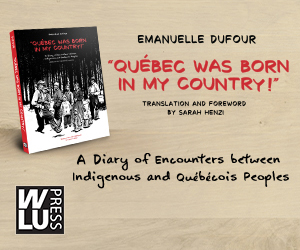Augur Magazine's Kerry C. Byrne on Breaking the "Arbitrary Line Between 'Literary' and Speculative Literatures"
Literary magazines are often the unsung heroes of the writing and publishing community. Run by passionate and knowledgable writers and editors, they are labours of love where people who adore great writing pour their time and energy into discovering and uplifting a variety of voices.
And so, an addition to the world of literary magazines, especially one that fills a gap in the landscape, is cause for celebration not only for writers, but for readers.
Enter Augur Magazine, now in its fourth year publishing, which has carved out a niche blurring the old-fashioned divisions between speculative and literary writing, publishing spectacular, strange, innovative pieces.
We're speaking today to co-founder and Publisher Kerry C. Byrne, who has shepherded Augur from its infancy, staying true to the mission to seek out "writing that is difficult to classify—whether speculative, surreal, or slightly strange," as the Augur mission statement reads.
Kerry tells us about the student journal they created that served as a blueprint for Augur, why the magazine's payment policy means more than just much-needed dollars in writers' pockets, and what they see (and hope) for the magazine's future.
Open Book:
Tell us a little about how Augur came about. Where did the idea come from and how did your team come together?
Kerry C. Byrne:
For me, Augur was always inevitable.
During my final year at the University of Toronto, I launched a student journal. The Spectatorial. I branded it as the University of Toronto’s only genre journal, won money from the University’s grant program for new student projects, and put out two issues that year.
In many ways, The Spec was the blueprint for Augur. In structure—submissions, team-building, editorial process—but also in team members. Our entire leadership team, as well as our cover artist and other team members, are graduates of The Spectatorial! However, in the last year, we’ve also started bringing on team members from intensive application processes: and we’re so grateful to have this net new talent with us.
After graduating, I knew I would want to build on the foundation I’d laid at The Spec. So I took a couple of years, aligned with my two co-founders—Alexander De Pompa, our current COO and former Editor in Chief, and Mado Christie, our former Senior Editor—and figured out what type of magazine we thought was needed. What type of magazine we wanted to create.
Your CanLit News
Subscribe to Open Book’s newsletter to get local book events, literary content, writing tips, and more in your inbox
We landed on three core priorities:
- Publish work that is speculative, work that is a dreamy form of realism, and work that sits somewhere in between, so we can break down the arbitrary line between “literary" and speculative literatures
- Publish dominantly Canadian and Indigenous creators, as the only SFWA-recognized professional magazine in Canada—creating more opportunities for Canadian and Indigenous creators to be eligible for SFWA status
- Commit to purposefully making room for under-represented creators, while building a team of under-represented editors
But it all comes back to a simple thought: publish amazing creators, who write fantastic genre-bending work, and support our literary community in growing speculative excellence by paying them well.
OB:
Augur has a unique editorial mandate – how would you describe the work that you publish and are looking for?
KCB:
No one will like this response, but it’s so difficult to say. Unique is right: every issue is unique!
On a personal level, it’s because my decisions are guided by experiential, or even synaesthetic, motivators. How do I feel while reading it? What emotions are evoked? Am I liking it (I believe strongly in the value of liking things, without qualification)? And then, most importantly: if I work on this piece, what do I think I have to offer the creator?
On a team level, it’s because we publish collaboratively. Every issue is hand-selected by a team of thirteen staff, in a pitch-and-advocate meeting that can run up to ten hours. With every issue shaped by so many perspectives, it’s really a matter of how we come together.
On an Augur level, it’s because we’re inherently interested in liminal work! So many things can be an Augur piece: it’s more of a tone, or a vibe, or an experience rather than something strict or specific. We accept work across many genres, from high fantasy to soft science fiction to realism to fabulism to dystopias to horror to dark fantasy…
Personally, I have a soft spot for soft scifi mech stories and pretty fantasy vignettes with zero plot. As a team, we’re drawn to pieces that evoke powerful feeling.
In the future, I’m looking for more works about celebration, safety, adventure, and delight. We’ve been heavier, more horror-driven, the last little while, and while I value every piece we’ve published, I want to make it clear that we leave room for everything else, too.
OB:
There are of course a number of excellent lit mags in Canada at the moment. What does Augur add to the mix that you needed to see more of in the field?
KCB:
I think, for us, it comes back to the three core priorities I listed up at the top.
On the liminality of what we publish, we’ve often received feedback from writers that they send work to Augur that doesn’t belong anywhere else. I love that feedback. I love that the way we approach genre lets us be that market for them: and I love knowing that we’re filling a gap for these writers, and giving their work a home.
Currently, we are also the only Canadian magazine recognized as a professional market by the Science Fiction and Fantasy Writers of America. What that means is we pay SFWA-recognized rates ($0.11/word CAD for fiction, or $110 per 1000 words), and that anyone we publish is eligible to become an associate member of the SFWA. For us, becoming SFWA-recognized was a huge focus, because it meant that the Canadian, Indigenous, and worldwide writers we published would have more opportunities in their careers.
On an internal, level, though: something I really wanted to see in Augur, when we launched, was an organization based on care. Publishing is hard. It’s very, very hard. I want our space to be supportive, and I want both my team and our creators to feel valued. We do a lot to try and make that happen, including: ensuring that we respond to all submissions (thousands per reading period) in two months, providing notes to longlisted authors we don’t publish, doing training for editors on how to edit compassionately, and running surveys on creator experience. That said, there’s always room to grow, and I’m very grateful for the leadership team (Terese Mason Pierre, Lawrence Stewen, and Victoria Liao) in partnering with me on continuing to develop what we’re able to offer our team and authors.
OB:
I know it’s hard to narrow it down, but can you tell us about a piece or two you published recently that really excited you?
KCB:
Oh, this is incredibly difficult! I’m limiting myself to our most recent issue, Issue 3.2, in order to make it easier.
First, I’d be remiss if I didn’t shout out “Electrify the Bones” by Ren Iwamoto, which I edited for this issue. This love-letter-slash-critique of the mech genre is a quiet vignette about a queer mech mechanic, that manages to be deeply human while evoking a world much larger than a piece this short should rightfully host. Even better, Ren is one of our new Assistant Editors this year.
Second, I’ll have to direct people towards “Are We Ourselves” by Michelle Mellon. Told from the perspective of a Black man, this story takes place centuries in the future when white people are found most vulnerable to a new disease. As a means of keeping them “alive,” the consciousnesses of powerful white people are uploaded into the minds of Black and Indigenous people, as well as People of Colour. Supposedly temporary, supposedly painless: but never resolved, as these invasive consciousnesses threaten to take over their hosts. This piece operates on a level of craft that gripped our entire team, and is one of the most important stories I think we’ve published.
OB:
Where do you see (or would you like to see) Augur in five years’ time? What about further down the road?
KCB:
We’re entering our fourth year now, so five years is a ways away! But we’re definitely looking to grow. Augur Magazine is just one project by our parent Nonprofit, the Augur Magazine Literary Society, for which I am the CEO. Last year, I partnered with Terese Mason Pierre, Augur’s Co-Editor-in-Chief, to launch AugurCon, a conference for speculative literature in Canada. We’ll be running AugurCon again in 2022.
This year, we’ll be launching new programming through a series of workshops that Terese is putting together.
As for the magazine, we’re hoping to launch a sibling magazine to Augur called Tales and Feathers, which will be a magazine that publishes slice of life fantasy vignettes. That will likely be out later this year. We’re also hoping to launch an audio program for our issues, release in print, and start a podcast.
Farther in the future, I’m looking to create a chapbook, anthology, and novella press, so we can support the type of work we love in more mediums. But that will be a few years yet, and dependent on the ways we’re able to grow our revenue streams and our relationships with granting bodies.
Whatever we achieve, and whenever we achieve it, though—I am very grateful to the team I get to do this work with, and for the creators who trust their art to us. I feel lucky, every day, that I carry that trust, and I hope to create a space worthy of it for many years to come.
_____________________________________________
For more information about Augur Magazine, visit their website or sign up for their enewsletter.
Kerry C. Byrne is an autistic, queer, and nonbinary writer and editor living in Toronto. They are the Aurora-Nominated Publisher and Co-Founder of Augur Magazine, and their work can be found in Fantasy Magazine, THIS Magazine, Kaleidotrope, and others. They spend their spare time diving deep into the endless void that is their homebrew D&D world. Find them on Twitter as @kercoby.


